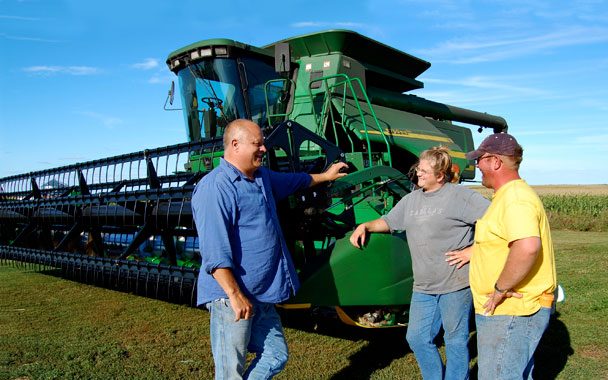Farmers on the northern Plains turned to the threat of frost last week. Nighttime temperatures have been dropping quickly here; they’re already into the low 40s. A “killer frost” (28 degrees Fahrenheit for four hours or more) now would wipe out the soybean crop only weeks before harvest. But then, with a wild twist, Labor Day weekend swept central South Dakota with three days of hot, dry winds that destroyed about ten percent of Dale Hargens’s bean crop.
Standing next to his harvest combine, Hargens makes a mental calculation. “I’ve got my beans sold for $12.70 a bushel. I figure I lost ten bushels an acre to the heat. That’s $127 an acre on 550 acres. In three days I lost around $70,000 to the hot wind.”
Add the soybean losses to a 40 percent hail loss in his wheatfields, south of town, and it adds up to a tough summer for Hargens. And yet, the explosive corn crop holds. If it comes in like Hargens expects, averaging 170 bushels an acre, it will make up for all the other losses.
Hargens, who is Minority Leader of the South Dakota State House of Representatives, will take the next two weeks to campaign among his neighbors. His daughter Andrea and her husband, Dave, are rushing to lay the foundation for a new home on the family farm. Then the soybean harvest begins, followed closely by sunflowers, and finally, corn. Then, winter. Time is about to get very, very short.
Once the harvest begins, the central pivot of the Hargens family life will be the massive, diesel-guzzling, John Deere model 9750sts harvest combine. The combine cost $330,000 new. The wheat/soybean flex head cost $40,000. The 12-row corn head cost $100,000. Dale Hargens has half a million dollars, almost twice the value of his home, invested in a machine he will use less than two months a year. The key to understanding the investment is to understand that during the next two months, everything has to go right. There is no margin for error, especially this year, when Hargens believes he will make the biggest harvest of his life. So he prepares meticulously.
The combine—spit-polish clean, John Deere green—sits on the edge of the cornfield. There are no broken blades on the mower, no broken or bent fingers on the rake. The machine was four years old when he bought it. He has used it for two harvests. It is ready for new tires. A set of four costs $4,500. After last year’s harvest, he paid the local maintenance shop $27,000 for annual maintenance and tune-up.




 Pinterest
Pinterest


